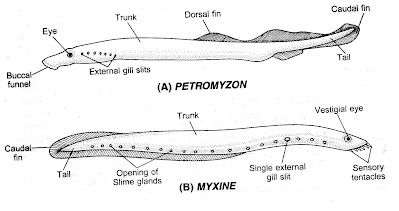Diagnostic Characteristics of Chordata
· Notochord: It is a solid, rod-like axial skeletal structure present below the nerve cord and above the alimentary canal.It is replaced by a vertebral column in adult vertebrates.
· Dorsal tubular nerve cord: It disappears in adult forms of urochordates. It remains throughout life in other chordates.
· Pharyngeal gill slits: Perforations in lateral walls of the pharynx.
Persist throughout life in a protochordate, cyclostomes, and fishes and help in respiration.
Pharyngeal gill slits: Not found in adult amphibians, reptiles, birds, and mammals.
General characteristics of Chordata
· True coelomates. Coelom is schizocoelic in origin.· Triploblastic, bilaterally symmetrical, metameric segmentation.
· Post-anal tail
· Paired appendages.
· Heart: muscular, ventral.
· Respiratory pigment: Hemoglobin is present in RBCs.
· Closed type of circulatory system with the hepatic portal system.
Sub-phylum: Hemichordata
· True notochord is absent, but has a primitive structure called stomochord is present which is the outgrowth of gut· They have dorsoventrally placed pharyngeal gill slits.
· Dorsal tubular nerve cord is present in the anterior end or collar region only.
· Body is divisible into proboscis, collar, and trunk
· Indirect development has a free-swimming larval stage called Tornaria larva
· That resembles bipinnaria larva of echinoderms.
Examples: Balanoglossus (Tongue worm) and Rhabdopleura.
· It represents the connecting link between echinoderm and chordates.
· Show retrogressive metamorphosis because the larval form has only a notochord but is absent in adults.
· They are commonly known as sea squirts.
Examples: Herdmaina (Sea potato), Salpa, Doliolum
Sub-phylum: Urochordata
· They are marine form. The body is covered by a test or tunic which is made up of a cellulose substance called tunicin. So-called tunicates.· Show retrogressive metamorphosis because the larval form has only a notochord but is absent in adults.
· They are commonly known as sea squirts.
Examples: Herdmaina (Sea potato), Salpa, Doliolum
Sub-phylum: Cephalochordata
· They are marine form.· Notochord is well-developed and extended up to the entire length of the body up to the anterior tip beyond the nerve cord so-called Cephalochordata.
· Pharyngeal gill slits open outside indirectly through an atrium and atriopore.
· They have an endostyle and ciliated groove in the floor of the pharynx used for getting food.
DIVISION: AGNATHA
· Eel-shaped body. A single class in existence i.e. Cyclostomata.· Lack jaws (a: absent, gnathos: jaw) and paired appendages.
· Circular mouth. (Cyclos = circular, stoma = mouth)
· Two chambered hearts.
6 – 15 pouch-like gill slits (Marsipobranchii)
· Lateral line sense organs.
· Exoskeleton lacking endoskeleton cartilaginous
· Internal ear with one or two semicircular canals.
· Notochord persists throughout life.
· Ectoparasites or scavengers on fishes.
· Development through Ammocoete larva.
Examples: Petromyzon (Lamprey, a living fossil), Myxine (Hagfish), etc.
 |
| Petromyzon and Myxine |
DIVISION: GNATHOSTOMATA
· Bear jaws (gnathos: jaw, stoma: mouth) and paired appendages.· Consists of two superclasses: Pisces and Tetrapoda.
Also, Read our Other Notes Important for Entrance Exams:
- Phylum Protozoa
- Leishmania donovani
- Amoeba proteus
- Phylum Porifera
- Phylum Coelenterata
- Hydra
- Phylum Ctenophora
- Phylum Platyhelminthes
- Liver fluke
- Tapeworm
- Phylum Nemathelminthes
- Ascaris lumbricoides (Roundworm)
- Wucheria bancrofti (Filarial worm)
- Ancylostoma (Hookworm)
- Enterobius (Pinworm)
- Phylum Annelida
- Earthworm
- Phylum Arthropoda
- Cockroach
- Mosquito
- Phylum Mollusca
- Phylum Echinodermata
- Phylum Chordata
- Pisces
- Amphibia
- Reptiles
- Aves (Birds)
- Mammals
